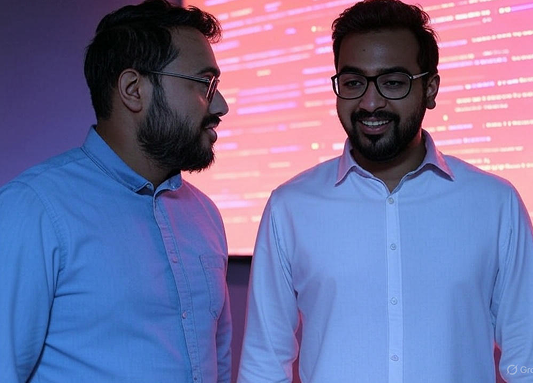
Your Ultimate Handbook for Mastering Full Stack Development
The Full Stack Software Development Training Program at Careertronic is a career-focused course that equips learners with in-demand skills in front-end and back-end development, UI/UX design, mobile and web apps, cloud computing, and DevOps. Guided by expert instructors, students engage in hands-on learning through live projects to build a strong portfolio. Careertronic’s 100% placement support includes personalized coaching to help secure high-paying roles at top tech companies. With a focus on real-world experience and cutting-edge technologies, the program prepares you to thrive in the fast-paced tech industry. Join Careertronic today to launch your successful software development career
Propgram Duration
12 Months
Time Commitment
12-15 Hrs/Week
Placement Support
900+ Companies
Enrollment
Highly Selective
How Can We Turn You Into an Expert in web development?
In-depth
Knowledge
Real World
Simulations
Placement
Assistance
Industry Requirements
What Tech Companies search for?

Amazon

Philips Engineering Solutions

International Business Machines

Microsoft Corporation

Reliance

One97 Communications

Samsung Electronics

Salesforce Inc.

Wipro Limited

Work Now Locally

Zensar

Tata Consultancy Services

Persistent

ANI Technologies Pvt. Ltd.

Groww (Nextbillion Technology)

Go Digit General Insurance
Required Skills
THE ONLY web development COURSE THATMakes You Industry-Ready & Future-Proof
Be job-ready for roles like Frontend Developer, Backend Developer, and Full-Stack Engineer with this all-in-one Web Development certification course.
Boost your resume by building 10+ real-world projects, from e-commerce platforms to social media dashboards—giving you the edge in any job interview.
Dive into sandboxed coding challenges, Git/GitHub workflows, and deployment using Netlify, Vercel & AWS. Strengthen your dev skills with hands-on practice from start to scale.
Our Curriculum
Expert-Design Course Structure
INTRODUCTION TO FULL STACK DEVELOPMENT
Why Learn This
Full Stack Development is essential for creating modern web applications by integrating frontend, backend, and database technologies. Learning the MERN stack provides developers with the skills to build scalable, efficient web applications from end to end while understanding the complete development lifecycle.
1.Role of full-stack developers in modern web development
2.MongoDB, Express.js, React.js, Node.js ecosystem
3.HTTP Protocol and RESTful services
4.Frontend, Backend, Database integration
5.Node.js, MongoDB, VS Code, Git configuration
NODE.JS & EXPRESS.JS
Why Learn This
Node.js and Express.js are fundamental technologies for backend development, enabling developers to build scalable server-side applications and RESTful APIs. Mastering these technologies allows for efficient database operations, server management, and the creation of robust web services essential for full-stack applications.
1.Core concepts, event-driven architecture, package management
2.Setting up routes, middleware, request-response cycle
3.API design principles, endpoints, HTTP methods
4.Configuration, environment variables, error handling
5.Database integration and management
6.Create, Read, Update, Delete functionality implementation
MONGODB DATABASE
Why Learn This
MongoDB is a powerful NoSQL database solution that provides flexibility, scalability, and performance for modern web applications. Learning MongoDB enables developers to store and manage unstructured data efficiently, create complex data relationships, and seamlessly integrate database operations within full-stack applications.
1.Document-oriented architecture, comparison with SQL databases
2.Schema design, document structure, BSON format
3.Model Creation, Querying, Relationships
4.insert, find, update, delete operations
5.Connection setup, middleware integration
6.Authentication, error handling, connection pooling
Authentication & Authorization
Why Learn This
Authentication and authorization are critical for securing modern applications. This course covers implementing user authentication systems, managing secure sessions, and controlling access based on user roles. Learn to protect APIs, implement token-based authentication, and follow security best practices to build robust and secure full stack applications.
1.JWT implementation, Passport.js strategies, OAuth integration
2.Securing APIs, token validation, refresh tokens
3.Permission models, access control, policy enforcement
4.Secure cookies, session storage, expiration policies
5.Password hashing, HTTPS, CSRF protection, input validation
REACT.JS
Why Learn This
Introduction to React.js - Objective: Learn the fundamentals of React.js for frontend development.
1.History and principles of React, component philosophy, virtual DOM
2.Component syntax, lifecycle methods, hooks vs class components
3.JavaScript XML syntax, expressions, conditional rendering, lists
4.Component communication, one-way data flow, useState hook, state management
5.Synthetic events, handlers, binding, forms and controlled components
6.Client-side routing setup, route parameters, navigation, nested routes
Advanced React.js
Why Learn This
Advanced React.js Concepts - Objective: Dive deeper into React.js for building dynamic UIs.
1.Custom hooks, rules of hooks, optimizing performance
2.Mounting, updating, unmounting phases, deprecated methods
3.Global state management, providers and consumers, context limitations
4.Form libraries, controlled vs uncontrolled components, validation techniques
5.Async operations, loading states, error handling, data caching
6.React DevTools, error capture, fallback UIs, performance profiling
READY FOR WEB DEVELOPMENT ROLES
Covering all modules above makes you ready to apply for Web Development roles
Frontend + Backend Integration
Why Learn This
Building Full Stack Applications (Frontend + Backend Integration) - Objective: Learn how to integrate frontend (React) with backend (Node/Express).
1.Request lifecycle, data formats, RESTful API design
2.Promise handling, async/await, request configuration
3.Loading states, error handling, response processing
4.Action creators, reducers, store configuration, middleware
5.Security considerations, CORS policies, proxy configuration
Styling and Frontend Design
Why Learn This
Objective: Improve the visual appeal of your frontend.
1.Modern layout systems, responsive containers, alignment techniques
2.Component-scoped styles, preprocessors, style organization
3.Component libraries, design systems, theming customization
4.Mobile-first approach, breakpoints, adaptive layouts
5.API authentication, data visualization, third-party services
6.Animations, transitions, user experience enhancements
Deploying Full Stack Applications
Why Learn This
Objective: Learn how to deploy MERN applications to the cloud.
1.Platform comparison, cost factors, scalability considerations
2.Performance optimization, security hardening, build processes
3.Secret management, configuration patterns, multi-environment setup
4.Platform setup, continuous deployment, monitoring
5.Static site hosting, build configurations, CDN distribution
6.Cloud database setup, connection security, scaling options
YOU'RE NOW READY FOR WEB DEVELOPMENT ROLES
Covering all modules above makes you ready to apply for Web Development roles
Testing Full Stack Applications
Why Learn This
Objective: Implement testing for both frontend and backend.
1.Testing frameworks, assertion libraries, test runners
2.API endpoint testing, database testing, middleware testing
3.Component rendering, state testing, snapshot testing
4.User flow simulation, browser automation, test reporting
5.Mock services, intercepting requests, stubbing responses
6.Breakpoints, logging strategies, performance profiling
FINAL PROJECT AND BEST PRACTICES
Why Learn This
The final project provides an opportunity to demonstrate mastery of full-stack development by building and deploying a complete MERN application. This module focuses on applying best practices in code organization, version control, and performance optimization while delivering a professional-quality application.
1.Combining React, Node, Express, and MongoDB
2.Folder structures, modular design, separation of concerns
3.Branching strategies, collaborative workflows, CI/CD integration
4.Lazy loading, code splitting, caching strategies
5.Authentication, state management, real-time features
6.Deployment strategies, documentation, feedback incorporation
Your Guide to Everything
Download Our Brochure for a Complete Overview!
Gain Real-World web development Experience!
Career-Boosting Projects
E-Commerce Platform
Build a feature-rich online store with product listings, shopping cart and payment processing.
Task Management System
Create a collaborative project management tool with task tracking and team communication features.
Social Media Dashboard
Develop a platform that integrates multiple social accounts for posting and analytics.
Healthcare Appointment System
Build a medical scheduling application with patient profiles and doctor availability calendars.
Real Estate Portal
Create a property marketplace with search filters, map integration and virtual tours.
Learning Management System
Develop an educational platform with course creation tools and progress tracking features.
web development Curriculum
Your Journey With Careertronic
Onboarding Session
Intro Session
Start in a customized cohort and forge meaningful connections who will be your allies on this journey.
Select the right mentor for guidance and gain invaluable insights to boost your career.
Connect with a Learning Coordinator
Live Learning Experience

Live Classroom
Engage with instructors and connect with your peers in real-time

Practice with
Assignments & Home Works

1:1
Guidance from Pro Mentors

Cloud Sandbox
Hands-on practice in real-world cloud environment

AI-Assisted
Problem-solving support

Situational
Problem & Solution

Teaching-Assistance
1:1 Teaching Assistant over chat & video call

Live Classroom
Engage with instructors and connect with your peers in real-time

Practice with
Assignments & Home Works

1:1
Guidance from Pro Mentors

Cloud Sandbox
Hands-on practice in real-world cloud environment

AI-Assisted
Problem-solving support

Situational
Problem & Solution

Teaching-Assistance
1:1 Teaching Assistant over chat & video call

Practice with
Assignments & Home Works

1:1
Guidance from Pro Mentors

Situational
Problem & Solution

Live Classroom
Engage with instructors and connect with your peers in real-time

Cloud Sandbox
Hands-on practice in real-world cloud environment

AI-Assisted
Problem-solving support

Teaching-Assistance
1:1 Teaching Assistant over chat & video call
Training & Placement Support
Module-Based Mocks
Practically apply your skills through interview simulations post-module.
Resume Building
Build an impactful, professional resume with expert mentorship.
Placement Training
Focused training to excel in tech recruitment processes.
Placement Support
End-to-end assistance to secure your dream job.
Meet Mentors & Instructors
Tap into the wisdom of web development Experts
Anshuman Singh
Naman Balla
Anshuman Singh
Anshuman Singh
Aman Sharma
This course is a must for anyone preparing for system design interviews! The real-world case studies on Uber, Netflix, and WhatsApp helped me understand how large-scale applications work. The explanations on microservices and database scaling were crystal clear. Highly recommended!.
Priya Desai
Great content with detailed coverage of caching, message queues, and load balancing. The instructor explained concepts in a structured way, making them easy to grasp. I just wish there were more coding exercises to practice system design problems.
Rahul Verma
As a backend developer, this course helped me improve my architectural thinking. Learning about CAP theorem, database sharding, and security best practices gave me a deeper understanding of system scalability. Definitely worth it!.
Full Stack Development Program
- Skills
- Certification
- Placement Support






Full Stack Development Program + Project Certificate
- Skills
- Certification
- Placement Support
- Portfolio
- 5+ Projects Certificate






Frequently Asked Questions
General
Who can take up this course?
Anyone interested in learning web development—from absolute beginners to those wanting to upgrade from front-end to full-stack—can join this course. No prior coding experience is required; we start from scratch.
What is included in your course?
This course covers everything from HTML, CSS, and JavaScript to advanced front-end frameworks (like React or Vue), back-end technologies (Node.js, Express), databases (MongoDB, MySQL), REST APIs, version control with Git, deployment, and best practices for responsive and accessible web design.
What will the student gain from your course?
By the end of this course, students will be able to build modern, scalable web applications from scratch. You'll understand how the web works, write clean code, connect front-end and back-end systems, deploy apps to cloud platforms, and follow real-world development workflows using Git and GitHub.
How is this course going to help a student get a job?
The course is project-based and industry-focused. You’ll build a full portfolio including real-world projects like e-commerce sites, blogs, dashboards, and portfolio websites. These hands-on experiences, along with GitHub repositories and resume assistance, make you job-ready for roles like Frontend Developer, Backend Developer, or Full-Stack Developer.
What are the job opportunities in this field?
Web development continues to be one of the most in-demand skills in tech. Companies of all sizes—from startups to tech giants like Google, Meta, TCS, Infosys, and Wipro—are always looking for web developers skilled in modern technologies. Freelancing, remote work, and product development are also viable career paths.




